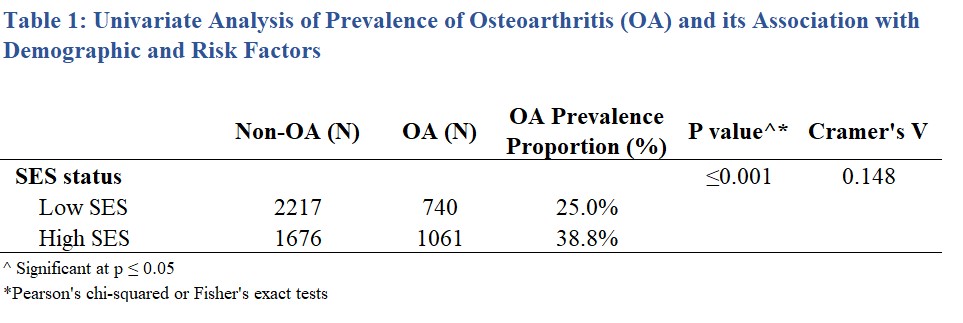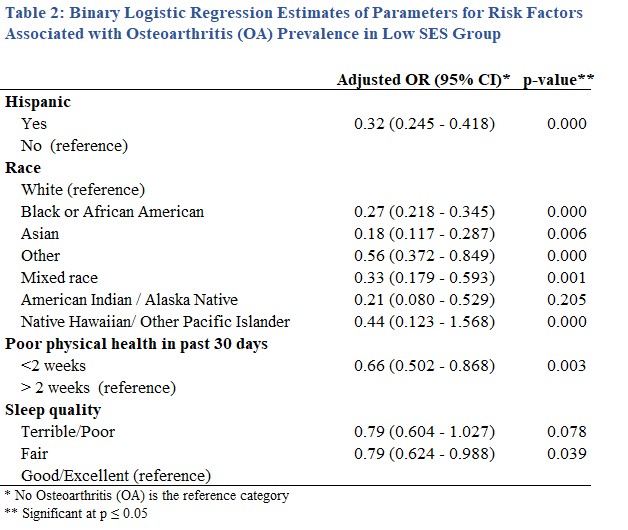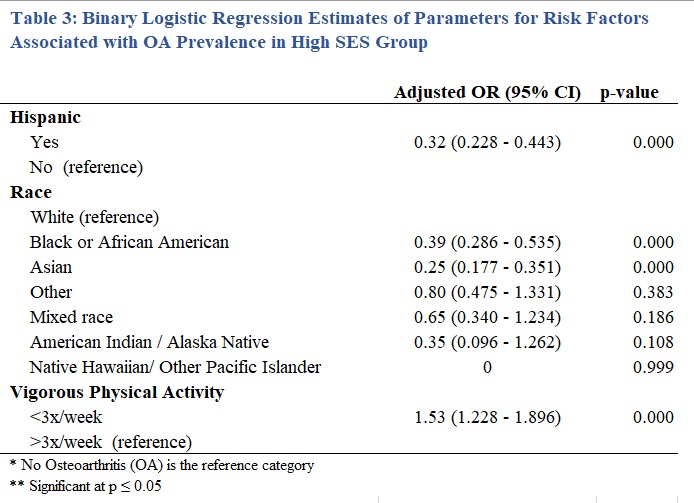Session Information
Session Type: Abstract Session
Session Time: 1:00PM-2:30PM
Background/Purpose: Osteoarthritis (OA) is a chronic, progressive condition affecting the musculoskeletal system, significantly impacting the quality of life and mobility of millions worldwide. It is notably prevalent among adults, particularly those over 65. OA is influenced by factors such as obesity, sedentary lifestyles, age, sex, sleep quality, and socioeconomic status. Understanding these risk factors, especially socioeconomic influences, is crucial for designing targeted interventions. Despite progress in identifying OA risk factors, gaps remain in understanding how socioeconomic status affects OA prevalence and outcomes. This study examined the relationship between OA prevalence and its risk factors across different socioeconomic status (SES) groups.
Methods: We addressed three research questions: the difference in OA prevalence between low and high SES groups, significant risk factors affecting OA prevalence in low SES groups, and significant risk factors in high SES groups. Using a retrospective cross-sectional design, we analyzed data from the 2022 Community Health Needs Assessment conducted by the New York Orthopedic Academic Medical Center. The sample comprised 5760 participants >18 years from New York State. SES was categorized based on income, education, and residence in Medically Underserved Areas (MUAs). Self-reported OA diagnosis was the dependent variable, with SES status and risk factors such as physical activity, physical and mental health, sleep quality, and demographics as independent variables. Statistical analysis included descriptive statistics, chi-squared tests, and logistic regression, with significance set at p< 0.001.
Results: Significant differences in OA prevalence were found between low and high SES groups (p≤0.001), with higher prevalence in high SES individuals (38.6%) compared to low SES individuals (24.6%). In the low SES group, Hispanics had significantly lower odds of OA compared to non-Hispanics (OR: 0.32, p< 0.001), and non-Whites had lower odds compared to Whites (p< 0.001). Those reporting less than two weeks of poor physical health (OR: 0.66, p=0.003) and those with fair sleep quality (OR: 0.79, p=0.039) had reduced odds of OA. In the high SES group, Hispanics had significantly lower odds of OA compared to non-Hispanics (OR: 0.32, p< 0.001), and Black/African Americans (OR: 0.39) and Asians (OR: 0.25) also had lower odds compared to Whites. Engaging in vigorous physical activity less than three times per week was associated with higher odds of OA (OR: 1.53, p< 0.001).
Conclusion: This study highlights significant disparities in OA prevalence between SES groups and underscores the multifaceted impact of socioeconomic, demographic, and lifestyle factors on OA. High SES individuals, despite better overall health metrics, showed higher OA prevalence, potentially due to lifestyle factors and healthcare access patterns. These findings emphasize the need for comprehensive public health strategies addressing SES-specific risk factors and promoting equitable healthcare access to reduce OA burden and improve outcomes across all socioeconomic groups.
To cite this abstract in AMA style:
Adeniran T, Cecil D, Amamoo A. Examining the Influence of Socioeconomic Status on Osteoarthritis Prevalence and Risk Factors Among New York Residents [abstract]. Arthritis Rheumatol. 2024; 76 (suppl 9). https://acrabstracts.org/abstract/examining-the-influence-of-socioeconomic-status-on-osteoarthritis-prevalence-and-risk-factors-among-new-york-residents/. Accessed .« Back to ACR Convergence 2024
ACR Meeting Abstracts - https://acrabstracts.org/abstract/examining-the-influence-of-socioeconomic-status-on-osteoarthritis-prevalence-and-risk-factors-among-new-york-residents/



